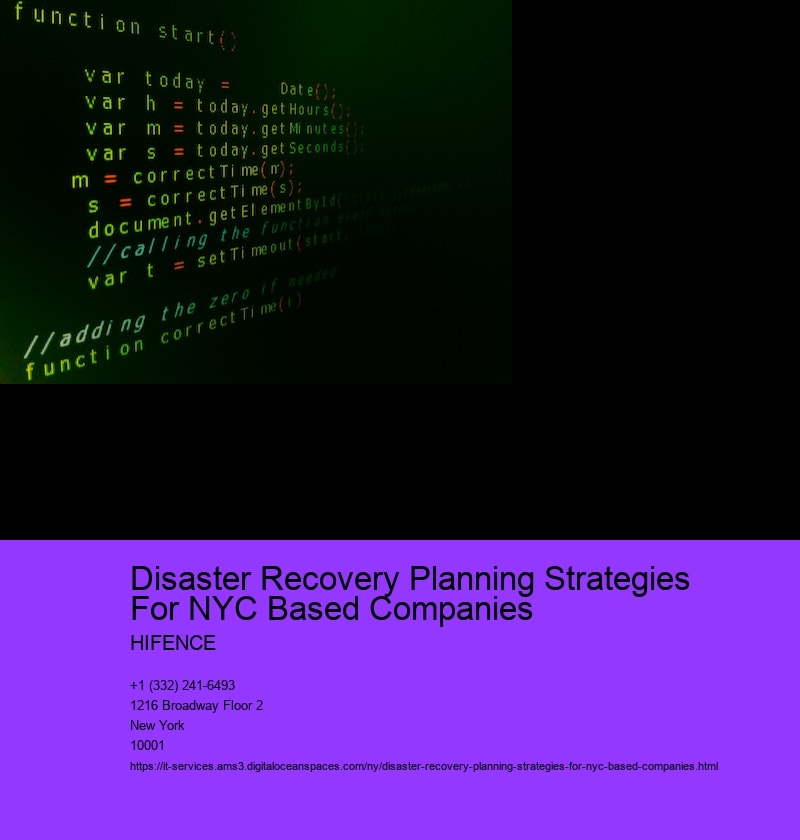Disaster Recovery Planning Strategies For NYC Based Companies
IT Operations Consulting
Definition of Disaster Recovery Planning
Disaster recovery planning is an essential part of any business in today's world. [object Object] Leveraging IoT Technology For Better Operational Efficiency Within Organizations Operating In New York City . It involves the development and implementation of strategies that will enable a company to protect itself from potential disasters such as cyber-attacks, natural disasters, power outages, and other events that could significantly impact operations. For NYC based companies, this means having plans in place to ensure their data remains safe and secure in the event of such a disaster. This includes making sure that backup copies are kept offsite, determining the best methods for restoring systems after a disaster strikes, creating policies to ensure compliance with relevant regulations, and testing these strategies regularly to make sure they are up-to-date. By doing so, businesses can reduce the risk of financial loss or downtime in case of an emergency situation.
Identifying Risks to Businesses in New York City
New York City is a bustling metropolis, filled with businesses of all sizes. With so much activity, it is important for companies in the city to be aware of the potential risks they may face and plan accordingly. One important strategy is to develop a comprehensive disaster recovery plan that can help mitigate any risks associated with natural disasters or other unforeseen events.
For businesses in New York City, identifying potential risks is essential to creating an effective disaster recovery plan. Companies should consider both internal and external factors that could lead to disruption in operations. Potential internal risks include employee turnover, data breaches, or technological outages caused by system failure or malfunctions. Mobile Computing Consulting External factors such as weather events, infrastructure breakdowns, power outages, and cyberattacks must also be taken into account when designing the recovery plan.
Developing an effective disaster recovery plan requires careful analysis of these various risks and their potential impacts on business operations. Business owners should conduct thorough assessments of their current systems and resources to determine what steps need to be taken in order to mitigate potential losses or disruptions. This includes analyzing existing backup technologies and solutions; creating strategies for maintaining continuity of operations; establishing protocols for responding quickly to incidents; developing data protection plans; creating emergency response plans; and testing systems regularly for vulnerabilities. IT Operations Consulting
By taking proactive measures like these, business owners in New York City can ensure that their companies are prepared for any eventuality. A comprehensive disaster recovery plan will help protect businesses from potential threats while keeping them operational during times of crisis or disruption.
Developing a Comprehensive Disaster Recovery Plan
Developing a comprehensive disaster recovery plan for NYC based companies is essential for mitigating potential losses in the event of a disaster. Such plans should include strategies for both preventing and responding to disasters, such as floods, earthquakes, or cyberattacks. Prevention strategies may involve implementing redundancies and backup systems, conducting regular testing of infrastructure, and providing adequate training to staff. Response strategies could include establishing an incident response team with designated roles and responsibilities, developing a communication plan to inform stakeholders of any disruptions, and creating detailed procedures for restoring operations. Finally, organizations should ensure they have adequate resources in place to implement their plans in the event of an emergency. IT Asset Management By taking these steps now, businesses can be better prepared to recover quickly when faced with unforeseen challenges.
The Components of an Effective Disaster Recovery Plan
New York City based companies must ensure they have an effective disaster recovery plan in place. Such a plan should include several components, including planning and preparation, risk assessment, data backup and protection, response protocols, and testing. Planning and preparation involves developing strategies for responding to various types of disasters as well as having the necessary resources ready to respond quickly. Risk assessment helps identify potential risks so that organizations can develop plans to mitigate them. Data backup and protection are essential for ensuring that data is secure in the event of a disaster. Response protocols provide guidance on how to respond quickly and effectively when a disaster occurs. Finally, testing allows organizations to evaluate their preparedness for responding to disasters. By incorporating all these components into their disaster recovery plans, New York City based companies can be better equipped to face any kind of emergency situation.
Testing the Plan and Practicing Emergency Procedures
Disaster recovery planning is an essential strategy for NYC based companies.
Disaster Recovery Planning Strategies For NYC Based Companies - Mobile Computing Consulting
- Mobile Computing Consulting
- IT Asset Management
- IT Audit
- Enterprise Architecture
- Hardware Selection and Procurement
Training Staff on Emergency & Disaster Response Procedures
In New York City, training staff on emergency and disaster response procedures is essential for businesses to develop effective disaster recovery plans. By providing employees with the necessary knowledge and skills, companies are better prepared to handle unexpected disasters. Training should focus on various emergency scenarios and how best to respond in each situation. Specific topics may include evacuation planning, fire safety protocols, communication systems, emergency medical care, damage assessment procedures, and post-disaster recovery strategies. Additionally, it is important that staff be familiar with local resources such as law enforcement agencies and crisis centers so they can access them quickly during an emergency. With proper training, NYC based companies can establish an efficient plan of action for responding to major disasters while minimizing potential damage and financial losses.
